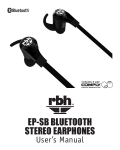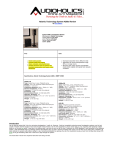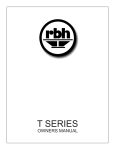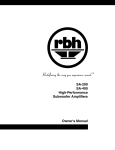Download RBH Sound CT-5 Specifications
Transcript
SUBWOOFER Owners Manual Introduction Congratulations on your purchase of an RBH Sound Subwoofer! Your subwoofer is the result of many years of research and development dedicated to producing powerful, accurate bass in home audio systems. This manual contains operating procedures and specifications. We recommend you thoroughly read through the material contained in this manual before connecting your subwoofer. This will ensure you have an understanding of how to setup and operate your subwoofer for optimum performance. Important Safety Instructions The lightning flash with the arrowhead symbol within an equilateral triangle, is intended to alert the user to the presence of un-insulated “dangerous voltage” within the product enclosure that may be of sufficient magnitude to constitute a risk of shock to persons. The exclamation point within an equilateral triangle is intended to alert the user to the presence of important operating and maintenance (servicing) instructions in the literature accompanying the product. When using your subwoofer, basic safety precautions should always be followed to reduce the risk of fire, electric shock, and injury. 1. Read and understand all instructions in the users manual before operating the Subwoofer. 2. Retain this user manual for future reference. 3. Follow all warnings and instructions in this manual and any marked on the back of the Subwoofer. 4. Never touch the woofers or push objects of any kind into the woofer. 5. The subwoofer should be connected to a power supply compatible with the power consumption requirements, see the specifications section of this manual. 6. If mounting the subwoofer on a stand, the wall, or other device only do so as recommended by an RBH Sound authorized technician. 7. Place the subwoofer a safe distance from all heat sources such as radiators, stoves, or heaters. 8. Do not operate the subwoofer near water—for example, near a bathtub, kitchen sink or in a wet basement; or a swimming pool. 9. Power supply cords should be routed so they are not likely to be walked on or pinched by items placed upon or against them. 10. Any service or repair required must be performed by qualified, RBH Sound authorized technician. 1 Break In Period Allow several hours of listening time to adequately break-in the Subwoofer. During the break-in period, the driver suspension will loosen. The result of break-in will be an increase in low frequency response, improved definition, and increased clarity and detail. Care and Cleaning To maintain subwoofer appearance, we recommend an occasional application of a general purpose no-wax surface and furniture cleaner. This may also be used to gently clean the aluminum cone surface. To clean dust from the grille cloth and cone surface, use a vacuum with a brush attachment. Features A subwoofer is a must-have component for any home theater or audio system. The performance of your subwoofer can greatly affect the overall performance of your system. Without the subwoofer, the deep bass on your music CDs and special effects on movie soundtracks may not be heard and/or felt. Think of a subwoofer as a vital component that adds excitement to your theater or music experience. A powered subwoofer has its own source of amplification (as opposed to passive or non-amplified subwoofers which require an additional power amplifier). At the heart of RBH Sound’s subwoofers are proprietary aluminum cone drivers. The special aluminum cone material combines stiffness, low mass and self damping properties producing superior definition and accuracy of bass frequencies. A powerful magnet, extended voice coil and bumped back plate give the drivers high excursion capability allowing high output capability and accurate dynamic reproduction. Subwoofers can add considerable low-frequency, deep bass performance to any home theater or audio system. All RBH Sound powered subwoofers incorporate discrete class A/B analog power supply amplifiers ensuring low distortion, high current output and proven reliability. Variable crossover, adjustable phase control and auto on/off are also included for convenience and easy integration with other speakers. Connectivity is made easy by allowing the subwoofer to be connected by either interconnect (line level) or speaker wire (high level). ™ stands for Tuned Aperiodic Vent. This technology allows a smaller cabinet volume to generate lower frequency response without the need for large passive radiators and extremely powerful amplifiers. By using TAV™ Technology, your subwoofer is able to incorporate two woofers in a relatively small enclosure with increased performance. TAV™ bridges the gap between vented and sealed enclosure subwoofers, providing better low frequency extension and efficiency than a 2 Features (continued) similar-sized sealed system. TAV™ technology shifts the vent tuning to a much lower frequency than would otherwise be possible in a small vented enclosure and also improves transient response. The MS-10.1 features the TAV™ Technology. The subwoofer cabinets are constructed from medium density fiberboard because of its inert properties. The thickness of the front baffles also prevents excess acoustic radiation. Large binding posts ensure a good electrical contact. Sophisticated computer modeling and measurement techniques are used extensively in the RBH Sound subwoofer design process. Setup Suggestions WARNING! Make certain the proper power cord is being used and the AC voltage selector switch is set to either 115V or 230V to match the power voltage in your area. Refer to the Amplifier Controls and Setup section of this manual. In order to obtain the best possible sound from your subwoofer, it is important to determine where the subwoofer will sound best in your listening room. Sound reflections from the floor, ceiling and side walls influence the balance, imaging and overall sonic quality at the listening position. Experiment with subwoofer placement to determine which location offers the best overall sound. Placement of the subwoofer will largely determine quality, quantity and extension of the bass frequencies within your listening room. Bass frequencies are reinforced by close room boundaries. Placing the subwoofer in a corner will make the subwoofer sound louder and boost the very lowest frequencies. Placing the subwoofer away from walls will provide the least reinforcement, making the bass sound subjectively thinner than if the woofer were closer to a wall. Good results can usually be obtained by placing a subwoofer along a wall 1-3 feet from a corner. Experiment with placement of the subwoofer and the sub-amplifier controls to achieve the proper bass balance. IMPORTANT NOTICE REGARDING BASS MANAGEMENT: It is important the signal being sent to the subwoofer be a non-boosted or “flat” signal. To be sure of this, check the settings on your receiver or processor to make sure any “bass boost”, “super bass” or “loudness” is set to Off. In most cases for home theater, setting a receiver or processor will determine the crossover frequency through bass management settings. In this configuration, connect the receiver or processor to the LFE Line Level Input. Your subwoofer can now reproduce the bass frequencies the way they were originally recorded. Use the subwoofer level control and the individual bass management control within the receiver or processor to adjust the subwoofers’ volume if necessary. Once set, the volume controls should not need to be altered as the subwoofer’s volume will coincide with the master volume control of your receiver or processor. 3 Setup Suggestions (continued) NOTE: There are several different surround formats available. Dolby Pro-Logic, Pro-Logic II, Dolby Digital and DTS generally have a 5 speaker plus subwoofer requirement. Dolby Digital EX and DTS ES add a center rear speaker. Please consult your audio/video professional to determine which system is best for you and how many speakers you will require. 4 Attach Stabilizing Feet Some RBH Sound Subwoofers come with stabilizing feet. To install, place each foot so the center hole of the foot is over each pilot hole on the bottom of the cabinet. Use the supplied screws to attach the foot to the cabinet, paying close attention to the fact that the pilot holes are drilled on an angle. This is done so the feet will be pulled in tight against the speaker cabinet. Install either the supplied spike or rubber mount as necessary into the threaded insert on the bottom of the feet. Amplifier Controls and Setup This section describes the functions and/or use for each of the amplifier controls located on the back of the subwoofer. See page 7 for the CT Series Amplifiers Control Diagrams; page 8 for the Signature Series and MC Series Amplifiers Control Diagrams. 1. Voltage Selector Switch: Before connecting the amplifier to any power source make sure the AC Voltage Selector is set to either 115V or 230V to match the power voltage in your area. WARNING! If the voltage setting does not match the AC power supplied, damage to the Subwoofer Amplifier may result. 2. Volume/Level Control: The volume/level control should be at the minimum setting (all the way counter-clockwise) before plugging the subwoofer into an AC wall socket. Once plugged in, turn the level control up one quarter of a turn (9 o’clock position) for an initial setting. The level control may be adjusted while playing to match the subwoofer level with the rest of the system. IMPORTANT! The volume control should be at the minimum setting (all the way counterclockwise) before plugging the subwoofer into an AC wall socket. 3. Crossover Frequency Control: The variable crossover frequency control allows you to set the low-pass crossover point of the subwoofer anywhere from 50-160 Hz. If using these inputs, experiment with setting the crossover frequency control at highest setting initially. Increasing the crossover frequency will allow more mid-bass output from the subwoofer. Decreasing the frequency will allow only deeper bass from the subwoofer. NOTE: Read the Important Notice on page 3 regarding bass management. 5 Amplifier Controls and Setup (continued) 4. Auto Signal Tracking: The subwoofer amplifier uses “smart” signal tracking circuitry. Once the power cord is plugged in and the switch set to auto, the amplifier automatically turns on when a signal is detected at the preamplifier or high level inputs and turns off when no signal has been detected for 15 minutes. 5. Phase Control: This control changes the phase of the subwoofer. Changing the phase will change the way the subwoofer and main speakers interact with each other at the crossover frequency. Varying the phase position may result in more or less mid bass depending on the phasing between the main speakers and the subwoofer. Generally, the phase is left at the 0° position. 6. Low-pass Switch: This switch allows the amplifiers internal crossover to be defeated when using an external crossover, or when the crossover is not needed. This switch should be in the “on” position when the audio signal sent to the subwoofer is not from a previously crossed-over source. The switch should be set to “off” when the audio signal sent to the subwoofer is coming from a source already using a crossover, such as the subwoofer pre-out from a receiver or pre-amplifier. This will ensure the subwoofer is not receiving an audio signal which is double-filtered. NOTE: Read the Important Notice on page 3 regarding bass management. 7. Line Output: These RCA terminals are for “daisy chaining” to another subwoofer or amplifier. A full-range signal is sent through these terminals. 8. LFE Line Level Input: Typically this will be the line level input used to connect to most receivers or processors. The LFE input will bypass the subwoofer’s crossover control. This input should be used when the input signal is coming from a receiver or processor where the bass management is controlled by the receiver or processor. NOTE: Read the Important Notice on page 3 regarding bass management. 9. High/Speaker Level Input: These binding post terminal connections are for the amplifier/speaker level input from an amplifier or receiver. IMPORTANT! Use either the Line Input or the High Level Input. DO NOT use them both simultaneously. 10. High Level/Speaker Output: This is a 100 Hz high-passed output for your satellite/main speakers. The crossover limits the low frequencies (below 100 Hz) from going to your satellite/main speakers. This crossover is active only when using the High Level Input terminals. Connect your main speakers (observing the proper polarity) to these terminals when using the High Level Inputs. 11. Fuse Access: This is the power fuse access. WARNING! In the event the fuse must be replaced, the replacement fuse must match exactly the original fuse value. If the replacement fuse is not of the same value, damage to the Subwoofer Amplifier may result. CAUTION! Before replacing the fuse, disconnect the power cord from the power receptacle. 6 CT Series Amplifier Diagram CT Series Amplifiers MS-8.1 and MS-10.1 7 Signature Series/MC Series Amplifier Diagram Signature Series Amplifiers 12-SE, 1010-SEN, and 1010-SEP MC Series Amplifiers TS-10AP, and TS-12AP, 8 Specifications Model: MS-8.1 MS-10.1 TS-10AP Series: CT CT MC System Type: Powered Subwoofer Bass Reflex with TAV™ Powered Subwoofer Powered Subwoofer Frequency Response: 35Hz-180Hz ±3dB 27Hz-180Hz ±3dB 30Hz-200Hz ±3dB Sensitivity:* N/A N/A N/A Recommended/ Rated Power: 200 Watt Amplifier 250 Watt Amplifier 200 Watt Amplifier Maximum Power Consumption: 400 Watts 500 Watts 400 Watts Drive Units: (2) 8” (203mm) Aluminum Woofers (2) 10” (254mm) Aluminum Woofers (1) 10” (254mm) Aluminum Woofer Crossover Frequency: 50-160 Hz (variable) 50-160 Hz (variable) 40-180Hz (Variable) Crossover Slope: 12dB / Octave 12dB / Octave 12dB / Octave Cabinet/Color: Black or White Black Black Oak Wood Grain Grille: Black or White (Metal) Black (Metal) Black Cloth Dimensions: 11¼” W (286mm) 13” H (330mm) 13¼” D (330mm) 13” W (330mm) 14¾” H (375mm) 17½” D (445mm) 14” W (356mm) 14¾” H (375mm) 17¾” D (451mm) Weight: 35 lbs. (15 .87 Kg) 45 lbs. (20.41 Kg) 45 lbs. (20.41 Kg) ` Warranty:** 5/1 Years 5/1 Years 5/1 Years1 1 1 * 2.83V @ 1 Meter ** Warranted from date of purchase to be free from defects and workmanship. 1 Warranty 5 years on the cabinet and woofers, and 1 year on the amplifier 9 Specifications (continued) Model: TS-12AP 1010-SEN 1010-SEP Series: MC Signature Signature System Type: Powered Subwoofer Non-powered Subwoofer Powered Subwoofer Frequency Response: 27Hz-200Hz ±3dB 24Hz-180Hz ±3dB 20Hz-180Hz ±3dB Sensitivity:* N/A 90dB N/A Recommended/ Rated Power: 200 Watt Amplifier 200-400 Watts 350 Watt Amplifier Maximum Power Consumption: 400 Watts N/A 700 Watts Drive Units: (1) 12” (305mm) Aluminum Woofer (2) 10” (254mm) Aluminum Woofers (2) 10” (254mm) Aluminum Woofers Crossover Frequency: 40-180Hz (Variable) N/A 40Hz-180Hz (variable) Crossover Slope 12dB / Octave N/A 12dB / Octave Impedance: N/A 4 Ohms N/A Cabinet/Color: Black Oak Wood Grain Black Oak Wood Grain with Gloss Black Tops and Bases or 30 different Real Hardwood Finishes Black Oak Wood Grain with Gloss Black Tops and Bases or 30 different Real Hardwood Finishes Grille: Black Cloth Black Cloth Black Cloth Dimensions: 16” W (406mm) 18¾” H (476mm) 20¼” D (514mm) 13¼” W (337mm) 30” H (762mm) 18” D (457mm) 13¼” W (337mm) 30” H (762mm) 19½” D (495mm) Weight: 55 lbs. (24 .94 Kg) 69 lbs. (31.30 Kg) 76 lbs. (34.47 Kg) Warranty:** 5/1 Years 5 Years 5/1 Years1 1 * 2.83V @ 1 Meter ** Warranted from date of purchase to be free from defects and workmanship. 1 Warranty 5 years on the cabinet and woofers, and 1 year on the amplifier 10 Specifications (continued) Model: 1010-SEN/R 1010-SEP/R 12-SE Series: Signature Reference Signature Reference Signature System Type: Non-Powered Subwoofer Powered Subwoofer Powered Subwoofer Frequency Response: 20Hz-180Hz ±3dB 18Hz-180Hz ±3dB 24Hz-180Hz ±3dB Sensitivity:* 90dB N/A N/A Recommended/ Rated Power: 200-600 Watts 400 Watt Amplifier 300 Watt Amplifier Maximum Power Consumption: N/A 700 Watts 700 Watts Drive Units: (2) 10” (254mm) Reference Aluminum Woofers (2) 10” (254mm) Reference Aluminum Woofers (1) 12” (305mm) Aluminum Woofer Crossover Frequency: N/A 40Hz-180Hz (variable) 40Hz-180Hz (variable) Crossover Slope: N/A 12dB/Octave 12dB/Octave Impedance: N/A 4 Ohms N/A Cabinet/Color: Black Oak Wood Grain with Gloss Black Tops and Bases or 30 different Real Hardwood Finishes Black Oak Wood Grain with Gloss Black Tops and Bases or 30 different Real Hardwood Finishes Black Oak Wood Grain with Gloss Black Tops and Bases or 30 different Real Hardwood Finishes Grille: Black Black Black Dimensions: 13¼” W (337mm) 130” H (762mm) 19½” D (495mm) 13¼” W (337mm) 130” H (762mm) 19½” D (495mm) 15½” W (394mm) 18” H (457mm) 18” D (457mm) Weight: 89 lbs. (40.37 Kg) 96 lbs. (43.54 Kg) 63 lbs. (28.58 Kg) * 2.83V @ 1 Meter ** Warranted from date of purchase to be free from defects and workmanship. 1 Warranty 5 years on the cabinet and woofers, and 1 year on the amplifier 11 Troubleshooting Situation: Probable Cause: Solution: No sound from subwoofer(s) Amplifier is not connected to constant power outlet. Make certain the amplifier is plugged into an unswitched AC power outlet. Amplifier is not receiving an audio signal from receiver or processor Make certain there is an audio signal from receiver or processor. Amplifier fuse might be blown. Replace fuse (if fuse is not readily accessible, consult your authorized RBH Sound dealer). The + and - polarity of the subwoofer wire might be reversed on the subwoofer. Check the entire system for proper polarity. Experiment with the phase switch settings. Crossover frequency not adjusted correctly. Adjust crossover frequency by turning the crossover frequency control clockwise until desired sound is obtained. L/R line level input is connected instead of the LFE line level input. If bass management is enabled on receiver or processor make sure to use the LFE line level input. (See the Amplifier Controls and Setup section of this manual.) Performance is less than expected 12 Warranty Your RBH Sound subwoofer is covered by a limited warranty against defects in materials and workmanship for a period of 5 (five) years on the woofer and cabinet, and 1 (one) year on the amplifier (if powered) from the original date of purchase. This warranty is provided by the authorized RBH Sound dealer where the subwoofer was purchased. Warranty repair will be performed only when your purchase receipt is presented as proof of ownership and date of purchase. Defective parts will be repaired or replaced without charge by your dealer’s store or the location designated by your dealer authorized to service RBH Sound products. Charges for unauthorized service and transportation cost are not reimbursable under this warranty. This warranty becomes void if the product has been damaged by alteration, misuse or neglect. RBH Sound assumes no liability for property damage or any other incidental or consequential damage whatsoever which may result from the failure of this product. Any and all warranties of merchantability and fitness implied by law are limited to the duration of this express warranty. Some states do not allow limitations on how long an implied warranty lasts, so the above limitations may not apply to you. Some states do not allow the exclusion or limitation of incidental or consequential damages, so the above limitation or exclusion may not apply to you. Redefining The Way You Experience Sound. TM 382 Marshall Way, Layton, Utah • USA • 84041 Toll Free: (800) 543-2205 • Fax: (801) 543-3300 www.rbhsound.com It is RBH Sound policy to continuously incorporate improvements into products; all specifications are subject to change without notice. Copyright © 2008 RBH Sound. All Rights Reserved.




























